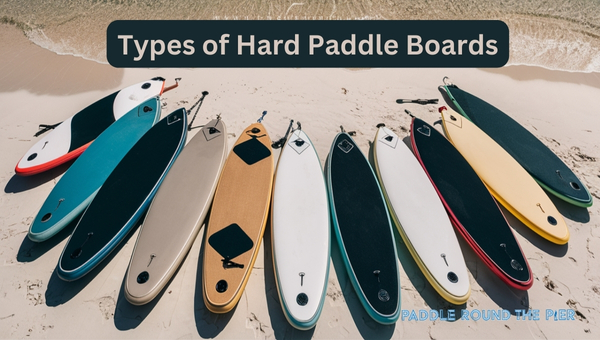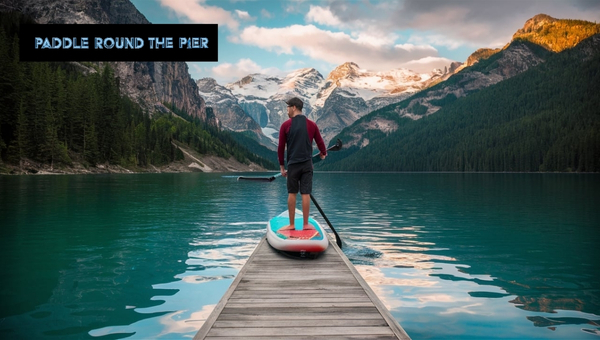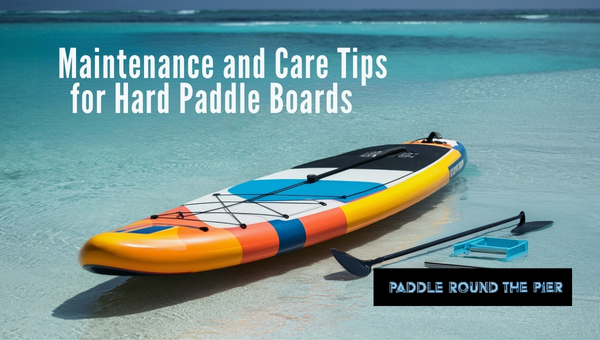Hard Paddle Board: Your Ultimate Guide to Choosing the Best
Are you eager to dive into the world of hard paddle boards? You've come to the right place! In this article, we'll explore the different types of hard paddle boards, their materials and construction, and how to choose the perfect one for your needs.
Plus, we’ll wrap up with essential maintenance and care tips to keep your board in top condition. Whether you're a beginner or an experienced paddler, this comprehensive guide has got you covered. Let’s get started and unlock the secrets of a hard paddleboard!
Types of Hard Paddle Boards

When it comes to hard paddle boards, there's a variety of options to suit every paddler's needs. Whether you're a beginner or an experienced enthusiast, understanding the different types of boards can help you make an informed decision.
1. All-Round Boards
All-round boards are the go-to choice for many paddlers due to their versatility. These boards are designed to perform well in various water conditions, from calm lakes to light surf.
They offer a balanced combination of stability, maneuverability, and speed, making them ideal for beginners and casual paddlers.
- Versatile: Suitable for various water conditions.
- Stable: Great for beginners.
- Balanced: Offers a mix of speed and maneuverability.
2. Touring Boards
Touring boards are specifically designed for long-distance paddling. Their shape and features make them perfect for covering large distances with ease.
- Longer Length: Provides better tracking and speed.
- Narrower Width: Enhances efficiency and reduces drag.
- Pointed Nose: Helps cut through the water smoothly.
3. Racing Boards
Racing boards are all about speed and agility. They are built to slice through the water quickly, making them perfect for competitive paddling.
- Sleek Design: Minimizes resistance for maximum speed.
- Lightweight: Easier to handle and maneuver.
- Narrow Shape: Reduces drag and enhances performance.
4. Surfing Boards
Surfing boards are designed to excel in waves, offering exceptional performance for those who love to ride the surf. These boards typically have specific features that make them stand out in the water.
- Shorter Length: Allows for quick turns and maneuvers.
- Curved Rocker: Helps in riding and carving waves effectively.
- Thicker Rails: Provide better grip and control in the surf.
- Durable Construction: Built to withstand the rigors of wave action.
Surfing boards are often crafted with a keen focus on performance in dynamic water conditions. The shorter length makes them highly responsive, allowing paddlers to make sharp turns and quick adjustments.
The curved rocker is crucial for maintaining balance and control while riding waves, ensuring a smooth and exhilarating experience. Thicker rails add to the stability and grip, making it easier to handle the board in challenging surf conditions.
Moreover, the durable construction ensures that the board can endure the wear and tear associated with surfing, providing a reliable and long-lasting option for enthusiasts.
By understanding the different types of hard paddle boards, you can better decide which one suits your needs and preferences. Whether you aim for versatility, long-distance paddling, racing, or surfing, there's a board designed just for you.
Also Read: Is Paddle Boarding Hard? Uncover the Reality Ahead!
Materials and Construction
When it comes to choosing the right hard paddle board, understanding the materials and construction is key. Different materials offer unique benefits, so let's delve into the most common ones: epoxy, fiberglass, and wooden boards.
Epoxy Boards
Epoxy boards are a popular choice for many paddle board enthusiasts due to their exceptional durability and lightweight properties.
Here's what makes epoxy boards stand out:
- Durability: Epoxy boards are known for their resilience. They can withstand a lot of wear and tear, making them ideal for frequent use.
- Lightweight: One of the main advantages is their light weight. This makes them easy to carry and maneuver in the water.
- Performance: These boards provide a smooth ride and are suitable for various water conditions.
Fiberglass Boards
Now, let's dive into fiberglass boards. These boards are well-regarded for their performance and versatility.
Here's a detailed look:
- Construction: Fiberglass boards are typically made by layering fiberglass cloth with resin, creating a strong and flexible board.
- Performance: They offer excellent performance, providing a good balance between speed and stability. This makes them suitable for both beginners and advanced paddlers.
- Weight: While not as light as epoxy boards, fiberglass boards are still relatively lightweight, making them easy to handle.
- Cost: They are often more affordable than epoxy boards, offering a good balance between performance and cost.
Wooden Boards
Wooden paddle boards are a work of art, combining craftsmanship and aesthetics.
Here's what you need to know:
- Craftsmanship: Wooden boards are carefully crafted, often by hand, making each one unique. The attention to detail in their construction is a testament to the skill of the builders.
- Aesthetics: These boards are visually stunning. The natural wood grain adds a touch of elegance that synthetic materials can't match.
- Performance: While they may be heavier than other types, wooden boards offer a smooth and stable ride. They are often used in calm waters where their weight is less of an issue.
- Durability: With proper care, wooden boards can last for many years, making them a good long-term investment.
Understanding these materials and their unique properties can help you make an informed decision when choosing a hard paddle board. Each type offers distinct advantages, so consider what matters most to you in terms of performance, durability, and aesthetics.
Also Read: A Comprehensive Guide: Inflatable vs Hard Paddle Boards
Choosing the Right Hard Paddle Board
Selecting the perfect Hard Paddle Board can feel like a big task, but we're here to simplify it. The right board will make your paddling experience enjoyable and efficient.

Let’s break down the essential factors to consider when choosing your board, focusing on dimensions, weight, and design.
Considering Board Length and Width
When picking a Hard Paddle Board, the length and width are crucial.
Here’s a guide to help you choose the right dimensions:
- Length: Shorter boards (under 10 feet) are great for surfing and making quick turns. Medium boards (10-12 feet) are versatile and suitable for various activities including yoga and casual paddling. Longer boards (over 12 feet) excel at touring and long-distance paddling because they glide more efficiently.
- Width: Wider boards (over 30 inches) offer more stability, making them ideal for beginners or activities like yoga. Narrower boards (under 30 inches) are faster and more agile, perfect for racing or experienced paddlers.
By considering how and where you'll use your SUP hardboard, you can find a length and width combination that suits your needs.
Assessing Board Weight and Volume
Evaluating the weight and volume of your Hard Paddle Board is essential for ease of transport and performance.
Here's what to keep in mind:
- Weight: A lighter board is easier to carry and transport. However, lightweight boards are often more expensive due to advanced materials. Consider how far and often you’ll need to carry your board.
- Volume: Volume is measured in liters and affects the board's buoyancy. Higher volume boards float better and can support more weight, which is ideal for heavier paddlers or those carrying extra gear. To find the right volume, consider your weight and any additional load you might carry.
Understanding Board Shape and Design
The shape and design of a Hard Paddle Board significantly impact its performance on the water.
Let’s explore the key design elements:
- Nose Shape: Boards with pointed noses (displacement hulls) cut through the water smoothly, enhancing speed and efficiency. These are ideal for touring and racing. Rounded noses (planing hulls) are more versatile and better for surfing and casual paddling.
- Tail Shape: A wider tail offers better stability, while a narrower tail improves maneuverability. Choose a tail shape based on your preferred activity—wider for stability and narrower for agility.
- Rocker: The rocker is the curve of the board from nose to tail. A higher rocker (more curve) helps in choppy water and waves, making it suitable for surfing. A flatter rocker (less curve) provides better speed and tracking on flat water.
By understanding these design aspects, you can pick a Hard Paddle Board that matches your paddling style and water conditions.
Also Read: 10 Best Kayak Paddles for 2024 | Expert Recommendations!
Maintenance and Care Tips for Hard Paddle Boards
Taking care of your hard paddle board is key to ensuring its longevity and performance. In this section, we'll dive into crucial tips for keeping your board in top condition. From routine cleaning practices to storage and transport tips, we've got all the details covered.

Routine Cleaning Practices
Maintaining the cleanliness of your hard paddle board is essential for its durability.
Here’s a detailed guide to help you keep your board spotless and in great shape:
- Rinse After Every Use: Always rinse your board with fresh water after each session, especially if you've been paddling in saltwater. Salt can cause corrosion and damage over time.
- Mild Soap Solution: Use a mild soap solution to clean the board's surface. Avoid harsh chemicals that might harm the material. A soft sponge or cloth works best.
- Focus on Fins and Edges: Pay special attention to the fins and edges of your board. These areas can accumulate dirt and debris that may affect performance.
- Dry Completely: Ensure your board is completely dry before storing it. Moisture can lead to mold and mildew, which are detrimental to the board's structure.
- Regular Inspections: Regularly inspect your board for any signs of wear or damage while cleaning. Early detection of issues can prevent bigger problems later.
Storage & Transport Tips
Proper storage and transportation of your hard paddle board are vital to prevent damage and ensure ease of use.
Here are some insights into effective storage techniques:
- Store in a Cool, Dry Place: Always store your hard paddle board in a cool, dry place away from direct sunlight. Prolonged exposure to UV rays can weaken the material and fade the colors.
- Use Board Bags: Invest in a good-quality board bag for added protection. Board bags shield your paddle board from scratches and environmental elements.
- Avoid Pressure Points: When storing your board, avoid placing heavy objects on it. Pressure points can cause dents and deformities.
- Transport with Care: During transport, ensure your board is securely fastened. Use proper racks or foam pads to avoid scratches and ensure stability.
- Vertical Storage: If space is limited, consider vertical storage. Use wall racks specifically designed for paddle boards to keep them safe and secure.
Repair Guidelines
Even with the best care, minor damage can occur. Knowing how to perform basic repairs can save time and extend the life of your hard paddle board.
Here are some simple repair methods:
- Minor Scratches and Dings: For small scratches and dings, use a waterproof epoxy resin. Clean the area thoroughly, apply the resin, and let it cure completely before use.
- Cracks and Deep Gouges: For more significant cracks or gouges, a fiberglass repair kit can be handy. Follow the kit’s instructions carefully, ensuring the damaged area is clean and dry before starting the repair.
- Fin Repairs: If your fins are damaged, they can often be replaced or repaired with a fin repair kit. Make sure the new fins are securely attached and aligned correctly.
- Regular Monitoring: After any repair, monitor the area for any signs of further damage. Regular checks ensure that the repair holds up and the board remains in good condition.
By following these maintenance and care tips, you can keep your hard paddle board in excellent shape, ensuring many enjoyable paddling adventures ahead.
FAQs
Are hard paddle boards better?
Hard paddle boards offer excellent performance and stability, making them ideal for various water conditions. They are durable and provide a smoother ride compared to inflatable boards.
How do you carry a hard paddleboard?
To carry a hard paddle board, use the built-in handle in the center of the board. If it doesn't have a handle, you can balance it on your head or shoulder for easier transport.
Do paddleboards flip easily?
Paddleboards are generally stable, but the likelihood of flipping depends on the board's design and the user's skill level. Wider boards offer more stability, reducing the chance of flipping.
Conclusion
Choosing the right Hard Paddle Board can significantly enhance your paddling experience. By understanding the different types and materials, you can make an informed decision that suits your needs.
Remember to consider board dimensions, weight, and shape for optimal performance. Proper maintenance and care will ensure your board lasts for many adventures to come.
For more tips and guides on paddle boarding, check out our other blog posts. Dive into our resources to become a paddle-boarding pro!